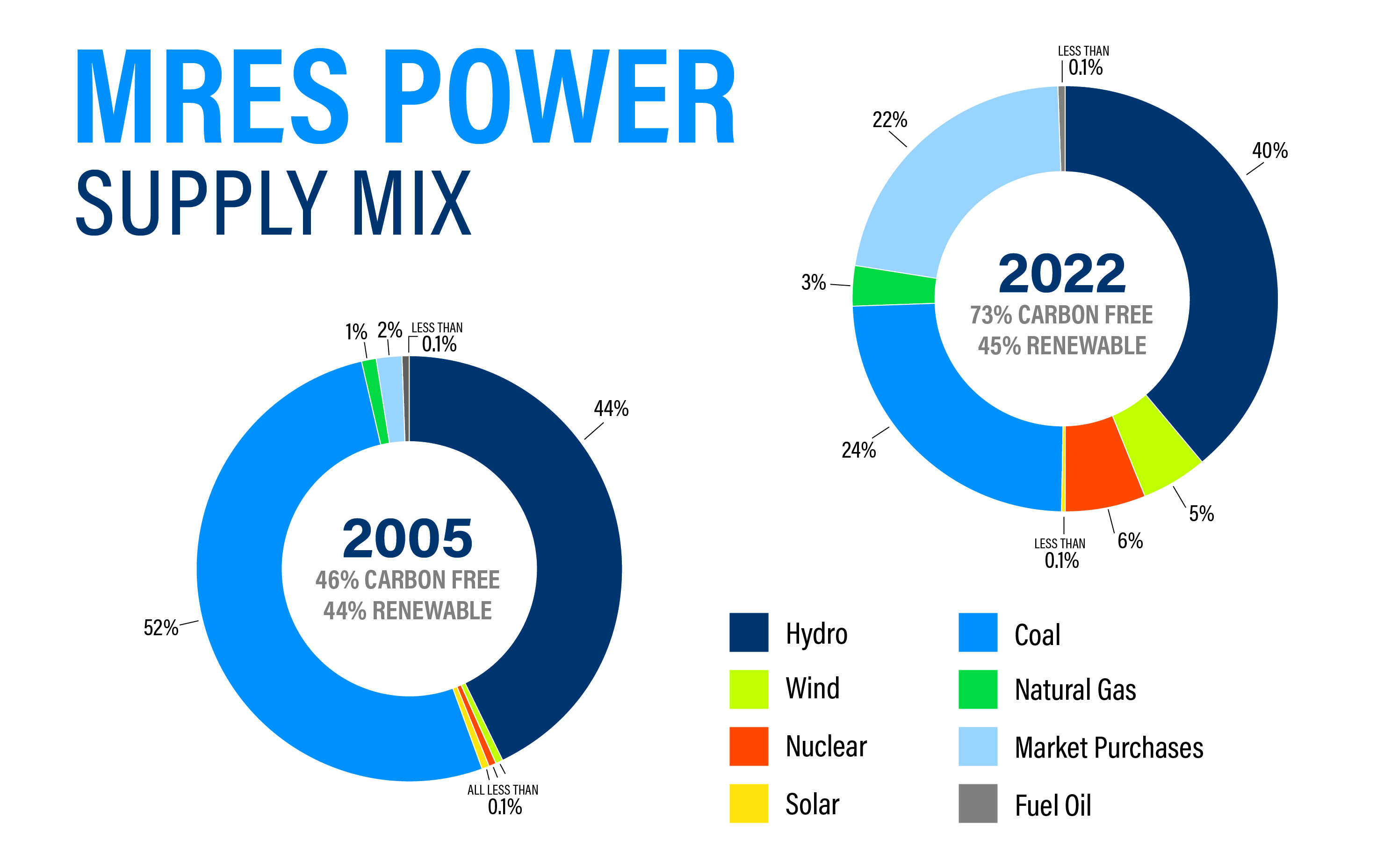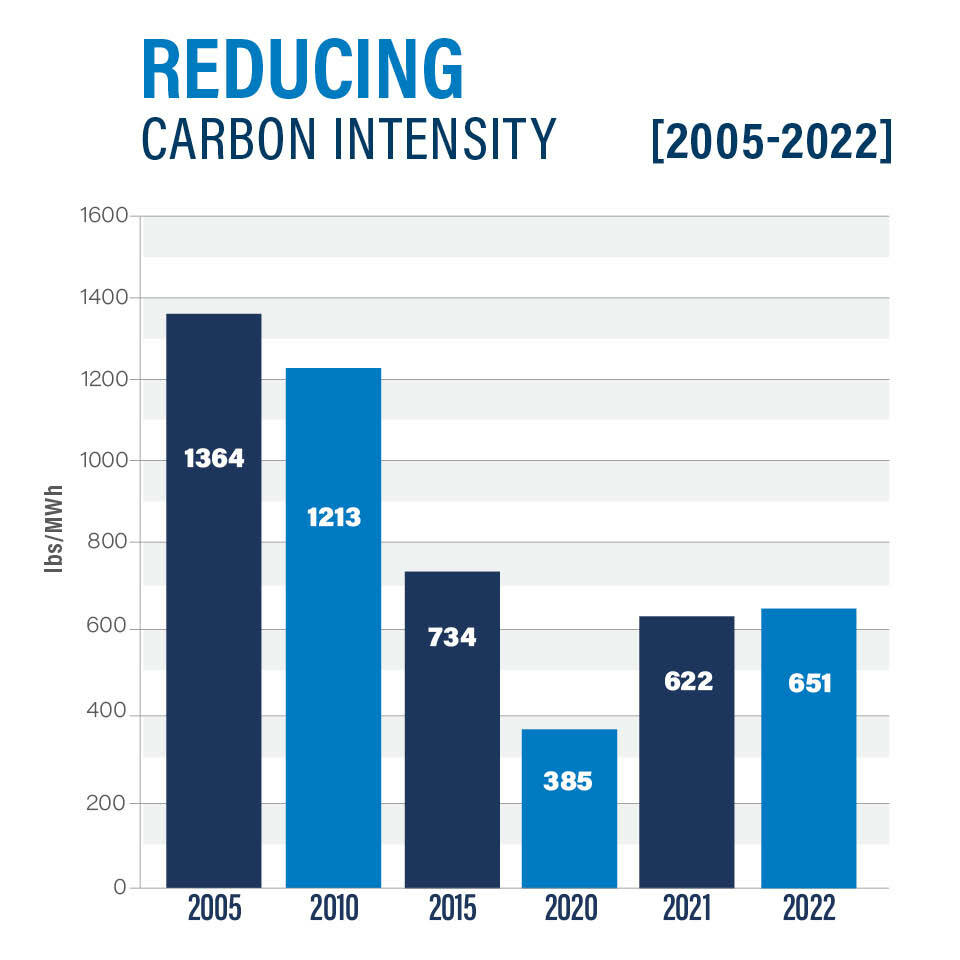Powering Your Future
MRES is committed to providing members and communities with efficient, cost-effective, reliable and ever-increasing clean energy. We’ve built a diverse portfolio of generation resources to reduce risk, increase reliability and focus on environmental stewardship. We work hard every day to find balanced solutions that will meet the electrical needs of our members and the thousands of customers they serve across our four-state service area.
Learn more about MRES, including our mission and vision.
Energy Sources
Fifty-nine of our 61 members receive an allocation of hydropower from the dams on the Missouri River, and they purchase, on average, about 40% of their energy needs from the federal government’s Western Area Power Administration (WAPA). MRES meets their remaining power supply needs with our diverse and reliable energy sources below.
Creating a Clean and Resilient Energy Future
Creating a clean and resilient energy future is a top priority for MRES and our members, and we are delivering affordable, reliable, and ever-increasing clean energy to our members and their customers.
Over the past 15 years, MRES has added renewable and carbon-free resources to our power supply mix, including nuclear, wind and solar resources. In addition, MRES built a new hydroelectric power plant — the Red Rock Hydroelectric Project — near the member community of Pella, Iowa, that began commercial operation in June 2021.

As part of its commitment to a cleaner energy future, MRES launched the Bright Energy Choices program on Jan. 1, 2020, which allows members and their customers to offset the fossil fuels in their power supply mix through the purchase of Renewable Energy Certificates (RECs), making their energy, in effect, net-zero carbon. In our decisions, we’ve focused on environmental stewardship, along with reducing risk and increasing reliability.
Counting Environmental Attributes of Energy Market Purchases:
As a generator of electricity, MRES takes responsibility for all emissions produced on its behalf from fossil fuel resources, whether used for member load or sold as surplus into an energy market. As a generator, MRES is also entitled to the RECs for energy generated at the Red Rock Hydroelectric Project and wind and solar farms that are owned by or under contract to MRES. This approach and methodology are consistent with the way nitrogen oxides and sulfur dioxide emissions are currently treated under the Clean Air Act.
For this reason, MRES considers market purchases free from any environmental attributes (renewable or otherwise) since the resource owner has the right to all renewable attributes from the energy they generate and sell into the market, they also must take responsibility for the emissions from the energy they generate and sell into the market. The purchasers of energy from the market do not control, or have knowledge of, the specific resources they are purchasing from hour to hour. The market participants who purchase the energy cannot choose the type of resource they want, such as renewable or carbon-free resources only, for example. The purchasers have to take the mix of resources that is available at the time of the purchase.
Energy Market Operation:
The energy market determines which generating plants operate hour by hour, based on the least-cost resource available. MRES enters bids hourly to sell the energy from all of its generating resources into the market. When there are plentiful wind resources available, those are always called upon to operate first before higher-cost resources, such as natural gas or coal. This has allowed MRES to greatly reduce the operation of our coal-fired power plant and purchase less expensive energy from the market when wind is abundant. Whenever the MRES fossil-fuel resources are not called upon to run, that means MRES is buying electricity cheaper than we can produce it ourselves. However, fossil-fuel resources are tremendously important for reliability when intermittent renewable resources are not able to operate.
Learn More — MRES Sustainability Report
2022 — 73% Carbon Free
Greenhouse gases, and specifically carbon dioxide (CO2), are a source of concern due to their association with global warming. That’s why MRES has been tracking our CO2 emissions and working to reduce our carbon footprint for the past 17 years.
In 2005, our baseline year for tracking CO2 emissions, the MRES member power supply resource mix was 46% carbon-free, largely due to members’ allocations of hydropower. In 2022, MRES members achieved an 73% carbon-free energy mix through the addition of renewable and carbon-free resources, along with the reduced operation of our coal-fired power plant.


Carbon Intensity Reduction
Since 2005, MRES has reduced its carbon intensity — the amount of CO2 emissions per kWh — as the result of increased energy sales, increased use of clean energy resources and decreased use of carbon-emitting resources.
Counting Environmental Attributes
MRES takes responsibility for all emissions produced on its behalf from fossil fuel resources, whether used for member load or sold as surplus into an energy market. MRES is also entitled to the Renewable Energy Certificates (RECs) for energy generated at the wind and solar farms that are under contract to MRES. This methodology is consistent with the way nitrogen oxides and sulfur dioxide emissions are currently treated under the Clean Air Act.
For this reason, market purchases are considered free from any environmental attributes (renewable or otherwise) because the resource owner is responsible for the emissions, or has taken credit for the renewable attributes, of energy sold into the market. Similarly, the purchasers of energy from the market have no way to mitigate emissions produced, nor do they have any right to the renewable attributes, for energy purchased from the market.

